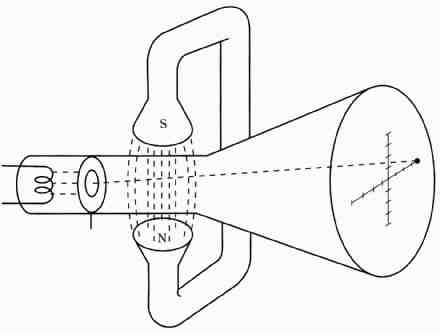AMAZON multi-meters discounts AMAZON oscilloscope discounts
.Having failed in the initial attempt to merge the effects of electrostatic and magnetic forces, it’s time to go back to the books. After some perusal and contemplation, you might produce two instances of motor action derived from the interaction of charges and magnetic fields. In both instances, charges are deflected when immersed in a magnetic field. In the first situation, illustrated in FIG. 9, the electron beam of a cathode-ray tube is deflected in the horizontal plane when vertically oriented magnetic lines of force are introduced. To be sure, this is not yet our desired goal of producing a force in a solid object, but it is nevertheless an encouraging experiment because it demonstrates that an interaction between the electric and the magnetic field can indeed be achieved.

FIG. 9 An example of motor action imparted to charges in a magnetic
field.

FIG. 10 A demonstration of the Hall effect.
The second situation, shown in FIG. 10, demonstrates the Hall effect. Here, a difference of potential occurs across the edges of a strip of conducting material in response to the simultaneous application of voltage and a magnetic field, which are space oriented as shown. The basic idea is that, without the magnetic field, no potential difference would be monitored by the microammeter. This is because the connections of the microammeter are at equipotential points with respect to the flow of the main current, that is, the current produced by the battery. In essence, the micro-ammeter is a null detector connected to opposite points of a balanced Wheatstone bridge. Assuming that the conducting strip is of homogeneous material, and that the microammeter is connected precisely at the center line dividing the length of the conducting material into two equal parts, you would not expect to monitor a difference of potential at right angles to the flow of the main current.
Does the introduction of the magnetic field alter the uniform conductivity of the strip? This, of course, could be offered as an explanation, and, in a sense, it is correct. However, it is the mechanism by which this apparent effect occurs that is interesting. Specifically, it comes about because of the “motor” effect of the magnetic lines of force on the electron drift, which is the main current through the strip. These drift electrons are deflected as shown in FIG. 10. Because of their resultant density at one edge of the conducting material, and their relative scarcity at the other edge, a difference of potential appears across the faces of the material to which the microammeter is connected. (What appears at first to be a demonstration of generator action turns out to be also an example of motor action.) Interestingly, the mutually perpendicular relationships of charge flow (electric current), magnetic field, and deflection are common to both experiments. Moreover, the directions of these quantities are also consistent in both phenomena. In summary, progress was made because it is clear that moving charges experience a deflection in a magnetic field.